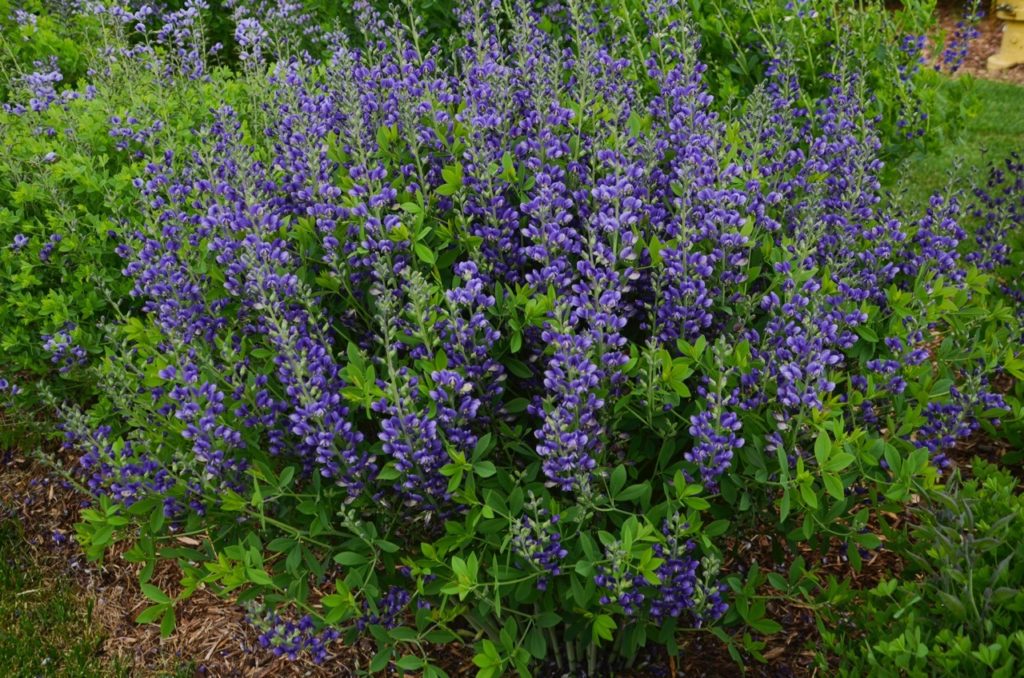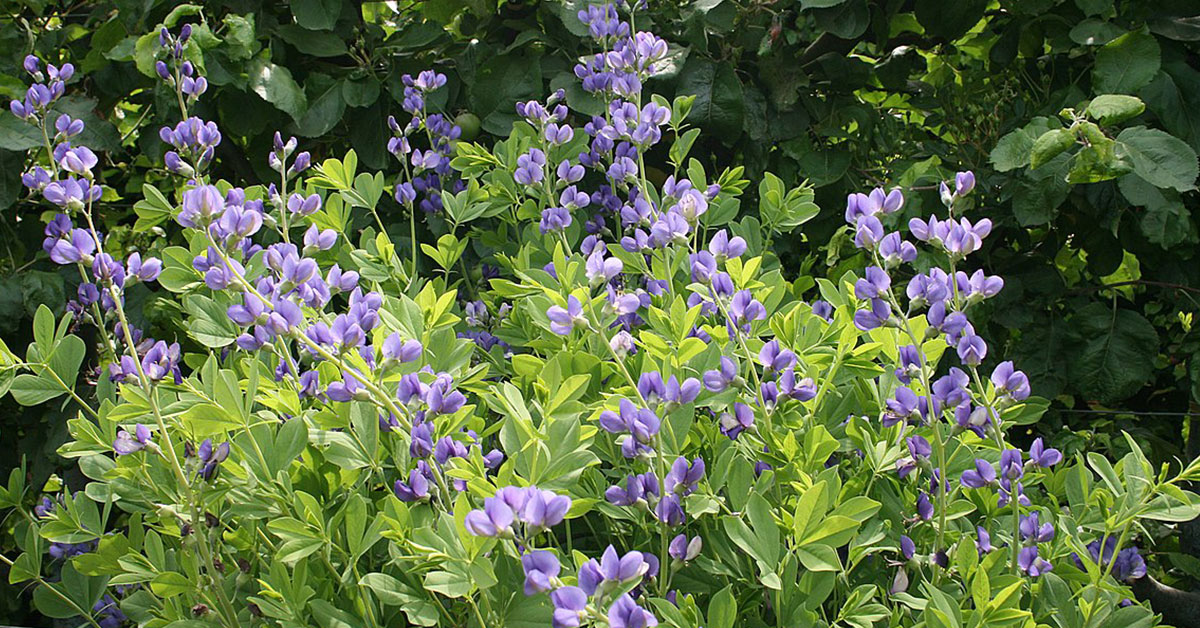Baptisia, popularly known as fake indigo or wild indigo, is a legume genus in the Fabaceae family. They are blooming herbaceous perennial plants with pea-like blooms that are followed by inflated pods. They grow naturally throughout eastern and southern North America in forests and grassland. Baptisia australis is the most commonly cultivated species. Its root is an ancient ingredient for medicines. The sap of wild indigo is also an important source of natural dye.
Tall spires of bright blossoms and gorgeous blue-green foliage characterize this rough native grassland plant. Flowers resemble peas or beans, which are closely related. After the blossoms fade, enormous clusters of beautiful seedpods appear. They dry out as they develop and make a rattling sound in the breeze.
Baptisias are available in a variety of hues, including blue, orange, purple, pink, white, and yellow, and they’re a fan favorite of bumblebees and other pollinators. Most baptisia plants produce blue blooms. Gardeners may now choose between pink, white, yellow, chocolate brown, and red flowering kinds, as well as bi-color combinations. The blue-green foliage of false indigo is attractive all year.
Read more: These 22 perennials will thrive in your garden for decades
Growing Baptisia
Baptisia australis is the most widely growing baptisia. While Baptisia australis is a lovely plant to have in the garden, it is not the star of the genus. One of the largest species, Baptisia australis, forms a 3′ tall x 5-6′ broad mound of glaucous blue-green leaves. In mid-April, the flower spikes emerge intact atop the freshly growing leaves. The flowers blossom in late April and range in hue from a deep blue to a deep purple, with each seed-grown plant being unique. The majority of Baptisia australis seed strains generate huge flower spikes that grow unstable as they age.
- Latin name: Baptisia
- Other names: Wild Indigo or False Indigo
- Native to: Eastern North America
- Invasiveness: No
- Tenderness: Herbaceous perennial
- Sun: Plenty of Sun
- Water: When required
- Soil: Well-draining, mildly acidic to neutral soils
- Hardiness zone: Zones 3 through 9
- When to plant: Early spring/late autumn
- Spacing: 90 cm
- Plant height: 3-4 feet
- Bloom period: Late spring to early summer
- Time to maturity: Up to three years
- Container friendly: Yes
- Fertilizer: Not necessary
- Toxicity: Mildly toxic to humans, animals
- Deer resistant: Yes
- Pest resistant: Yes
False indigo plants are adaptable and perennial in Hardiness Zones 3 to 9, but gardeners will have to wait a long time. Baptisia plants may be started from seed, although they take a long time to establish. Even a newly transplanted nursery plant will need at least a year to establish itself before blooming. It is preferable to spread Baptisia seeds at a depth of 6 mm in the early spring or late fall when growing them outside.
If you want to cultivate wild indigo indoors, start with peat pots and wait six to eight weeks before transplanting it to the garden. It takes one to five weeks for Baptisia species to germinate. These plants thrive for a very long time and may outlast their owners. The plant spreads slowly, and a matured clump resembles a distinctive shrub in the landscape.
Water
Keep false indigo watered frequently during the first year, but afterward, approximately an inch of water every two weeks will be enough. Baptisia is a drought-tolerant plant once established. This is a natural wildflower that thrives in most climates with whatever rains Mother Nature offers.
Sunlight
Without seeing at least six hours of direct sunshine every day, False Indigo will become floppy. Fungal illnesses are also prevented by exposure to the sun. Part shade is tolerated by this perennial, although it might result in weak shoots that require propping for support.
Soil
False indigo is a tough plant that may thrive in a variety of conditions, including poor soil. False indigo loves generally well-draining soils, but once established, it will survive dry conditions. It doesn’t care about the pH of the soil, however, it thrives in slightly acidic to neutral soil.
Fertilizing
Feeding these plants is not essential, and can even be harmful; excessive fertilization can lead the plant to become spindly and flop over.
Invasiveness
Although it is not categorized as invasive, Baptisia is frequently wrongly called such because of its deep root system, which makes it difficult to remove.
Baptisia is not a truly invasive plant since it does not cause ecological harm in a new area where it is not native.

Growing Baptisias in containers
Baptisias are well-suited to pots, especially the smaller varieties. Space for development and enough sunlight are two requirements for cultivating these plants in pots. Place the container where it will get lots of sunshine and water it as needed.
Care & tips
The amount of maintenance required is low. Plants can droop over from the center of the clump outwards, especially if they are cultivated in shaded circumstances and become lanky.
Large hoop support might assist maintain the plant upright in various conditions.
If you don’t deadhead the blossoms, you’ll end up with lovely seed pods that look like pea pods and bounce in the breeze.
You may avoid this by clipping your false indigo once it has finished flowering.
Stalks should be clipped at ground level as winter approaches—or as soon as fresh growth begins in the spring if you choose to keep the seed pods in place through the winter.
Common problems
False indigo plants are hardy. You don’t have to worry about animals eating them because they’re just moderately harmful. They are resistant to deer. Baptisias are susceptible to root rot, blights, fungal spots, blotches, powdery mildew, and worms, among other diseases.
Caterpillars, adelgids, and beetles are among the microscopic insects that can infest them. Occasionally, spider mites can also infest the plant.
Propagating Baptisia
False indigo propagation from seed necessitates fresh seeds for propagation, and new plants might take many years to blossom. Use stem cuttings to reproduce your plants for faster results. Take a stem cutting long enough to plant at least one set of buds in damp, loose soil in early spring, before the growing season begins. Maintain the stem cutting damp, and within a few weeks, a new root system will emerge.
The History Of Baptisia
Baptisia’s widely available blue variant, Baptisia australis, has traditionally been used as a dye. However, the industry considers it as “lesser” than the dye derived from “genuine” true indigo, Indigofera tinctoria, which is native to Asia. When settlers arrived in the New World, they noticed local Americans painting objects blue using a different sort of plant, which they dubbed “false indigo.” Although it was not as efficient as pure indigo, the need was the mother of innovation, so they termed it fake indigo, and the rest is history. The term Baptisia originates from the Greek root Bapto–which means to dip or immerse. Because people dipped their clothes or cloth in juice extracts, the plant acquired the name Baptisia. Nevertheless, this indigo dye was one of the earliest artificial fabric colors in human history.
Uses for Baptisia
The Baptisia plant is another original source of the indigo dye. The medicine made from its root is a potent anti-bacterial. Wild indigo is effective in treating infections such as influenza (flu), diphtheria, the common cold, swine flu, lymph node infections, malaria, scarlet fever, and typhoid. Tonsillitis, mouth and throat swelling, painful throat, boils, fever, and Crohn’s disease are all treated with it.
Some individuals use wild indigo directly on their skin to treat ulcers, vaginal discharge, uncomfortable and aching nipples, and clean open and swollen lesions. The plant contains poisonous alkaloids that have led to cattle poisoning. Although this plant has the potential to be harmful to people, there have been no reports of human poisoning.
These robust perennials with attractive flowers, fascinating seedpods, and a long season of appeal are nearly pest- and disease-free. They’re everything you could want for in a perennial. Wild indigos are low-maintenance plants that are easy to grow and survive a long time.













